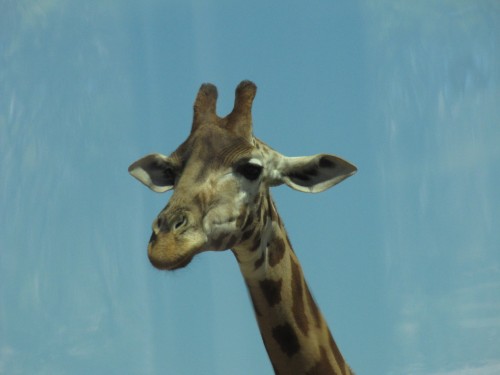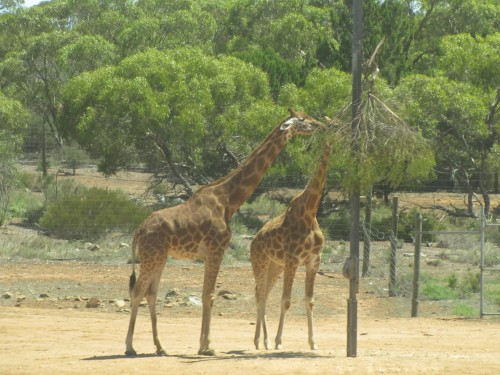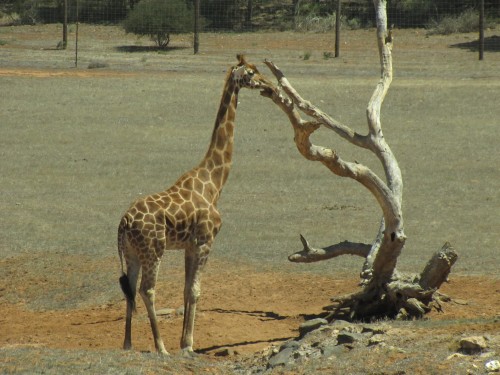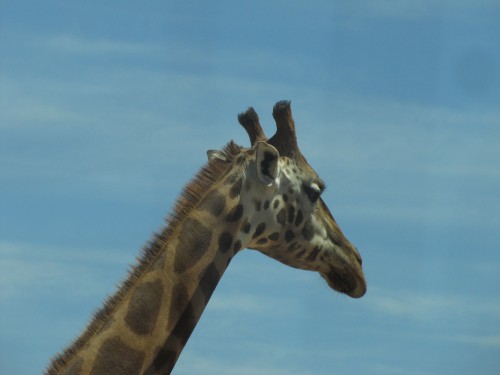Giraffes at Monarto Zoo South Australia
Giraffes always fascinate me. Partly because of their enormous height and partly because of the way they move. As for their height, males can grow to over 5 metres and the view from up there must be quite amazing. Of course it is very handy for grazing on the foliage of trees. At Monarto Zoo in South Australia where I took this series of photos earlier this year, any existing trees in their enclosure have been well and truly trimmed. The keepers try to simulate their natural environment by tying branches at the top of a tall pole (see below). Much easier for the giraffes than stretching down to the ground to eat the grass. With such a long neck, reaching the ground would be a decidedly difficult thing to do.
While visitors to the zoo do not often see the giraffes at full gallop, they can be remarkably agile over short distances considering their great size. Usually I have just observed them gracefully walking, again remarkable considering their size and weight; they weigh over a tonne (1,100 kg). The giraffe breeding programme at Monarto has been very successful over the years and the zoo now boasts the largest herd in Australasia.
Monarto Zoo is one of the largest open range zoos in the world and is a ten minute drive from my home in Murray Bridge. The area was designated many decades ago as a satellite city to our state capital, Adelaide, but plans fell through before any building could commence. The zoo is a part of the world renowned Adelaide Zoo.
Further reading:
- Find out more about giraffes from the zoo web site here
- Monarto Zoo
- Adelaide Zoo
Botanic Park, Adelaide, South Australia part 2
Adelaide, the capital of South Australia, has been deliberately planned with parks and gardens surrounding the CBD. Botanic Park is one such park and is located between Adelaide Zoo and Adelaide Botanic Gardens. The Bicentennial Conservatory is just a five minute walk from where I took these photos.
Links:
Historic elephant house at Adelaide Zoo
The beautiful old 19th century building shown above used to house the elephants at Adelaide Zoo. The zoo no longer houses elephants here and it has been converted into an historic interpretive centre (see photo below).
I can remember going for a ride on an elephant at the Adelaide Zoo when I was a child (more than 50 years ago). The last elephant held in this zoo’s animal collection died at the Monarto Zoo section a few years ago. While neither section of the zoo currently holds any elephants, I understand there are plans to re-introduce some to Monarto Zoo in the next few years.
Meerkats at Adelaide Zoo
Both sections of the Adelaide Zoo in South Australia have a god collection of Meerkats on display. These delightful animals are always a favourite with visitors to the main zoo in Adelaide as well as the Monarto section of the zoo.
Southern Hairy-nosed Wombat
The Southern Hairy-nosed Wombat can be found within about an hour’s drive of my home. Despite having driven in that area many times over the last three decades, I’ve only ever seen one in its natural habitat on a handful of occasions. Being nocturnal accounts for the main reason for not having seen it more often.
Mind you, I’d rather not encounter this lovely animal on a dark night on a lonely country road. I’ve almost hit one while driving along late at night and would rather not do so. Not only would a car fatally wound a wombat (which is something I’d hate), but the car would not be in a good state after a collision with one of these solid, dumpy animals. It would be like hitting a rock.
This species is also found in other parts of southern South Australia and Western Australia. See the photo below for more information. There are two other species of wombat: the Common Wombat and the Northern Hairy-nosed wombat, the latter being critically endangered.
Further reading:
- Wombat – information on the Adelaide Zoo website.












